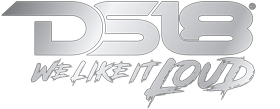When connecting amplifiers to subwoofers, it's important to understand the concept of impedance and how it affects the performance of the system. Subwoofers are available with either a Single Voice Coil (SVC) or a Dual Voice Coil (DVC), and each type has its own unique performance characteristics. In this blog, we'll explain the differences between single and dual voice coil subs, and we'll discuss the best practices for strapping amps to achieve optimal performance.
Let's start by defining impedance! In the context of audio systems, impedance refers to the electrical resistance of a speaker or subwoofer. Impedance is measured in ohms, and it's an important factor to consider when choosing and connecting audio components. The impedance of a speaker or subwoofer determines the amount of power that it can handle and affects the overall performance of the system.
Single Voice Coil subwoofers have one coil of wire, and they typically have an impedance of 4 ohms: Dual Voice Coil subwoofers, on the other hand, have two separate coils of wire, and they typically have an impedance of 2 ohms per coil. Because dual voice coil subs have two coils, they offer more flexibility in terms of wiring options and amplifier compatibility.
When strapping amps to single and dual voice coil subs, the main difference is the way that the amplifier sees the impedance. In a single voice coil configuration, the amplifier sees the total impedance of the subwoofer, which is typically 4 ohms. In a dual voice coil configuration, the amplifier sees only one of the coils, so the impedance is effectively halved to 2 ohms. This can affect the performance of the amplifier and the subwoofer while impacting the overall output of the system.

To achieve optimal performance, it's important to choose the right amplifier and subwoofer.
If you're a car audio enthusiast, you may be familiar with the concept of strapping competition amplifiers. For those who aren't competitors, Strapping is the process of connecting two amplifiers together to create a single, more powerful amplifier. This can be a great way to increase the output and performance of your car audio system, but it's important to follow the right steps to ensure that the amplifiers are connected properly. In this blog, we'll explain how to strap competition amplifiers to achieve optimal performance.
Step 1: Choose the right amplifiers.
The first step in strapping competition amplifiers is to choose the right amplifiers for the job. In general, you'll want to choose two amplifiers that are identical in terms of make, model, and power output. This will ensure that the amplifiers are compatible and that they'll work together to create a single, more powerful amplifier.
Step 2: Check the amplifier specifications.
Before you begin strapping the amplifiers, it's important to check the specifications for each amplifier to ensure that they're compatible. In particular, you'll want to check the power output, the impedance, and the input and output connections. Make sure that the amplifiers have the same power output and impedance, and that they have the same type of input and output connections. This will ensure that the amplifiers can be connected together properly.
Step 3: Connect the amplifiers together.
Once you've chosen the right amplifiers and checked their specifications, you're ready to connect the amplifiers together. First, connect the positive terminals of the amplifiers together using a high-quality power cable. Then, connect the negative terminals of the amplifiers together using another high-quality power cable. Make sure that the connections are tight and secure to ensure a reliable connection.
Step 4: Connect the amplifiers to the subwoofers.
Once the amplifiers are connected together, the next step is to connect them to the subwoofers. To do this, you'll need to use speaker wire to connect the output terminals of the amplifiers to the input terminals of the subwoofers. Make sure the connections are tight and secure, and that the polarity is correct (positive to positive and negative to negative). This will provide power to the subwoofers and allow them to produce sound.
Step 5: Adjust the amplifier settings.
After the amplifiers and subwoofers are connected, you'll need to adjust the settings on the amplifier to ensure that it's operating properly. This may involve adjusting the gain, the bass boost, and the crossover settings to match the characteristics of your subwoofers. It's important to take your time and experiment with different settings to find the optimal configuration for your system.
Step 6: Test the system.
Once you've adjusted the settings on the amplifier, it's time to test the system to ensure that it's working properly. Start by playing a variety of music at different volume levels, and listen for any distortion or other issues. Adjust the settings on the amplifier as needed to eliminate any distortion and achieve the best possible sound quality.
In conclusion, strapping competition amplifiers is a great way to increase the power and performance of your car audio system. By following these steps, you can connect two amplifiers together to harness more power for your system.









